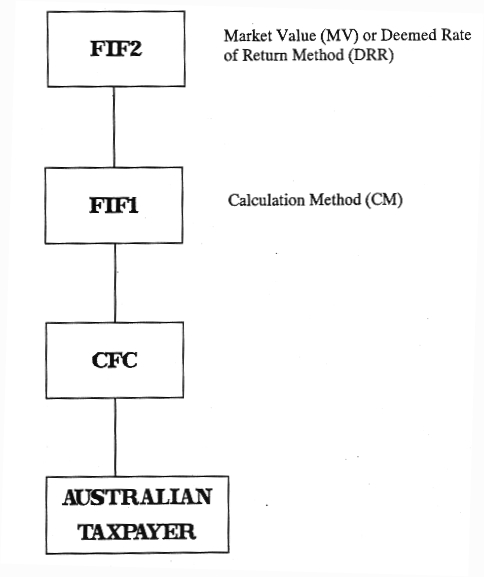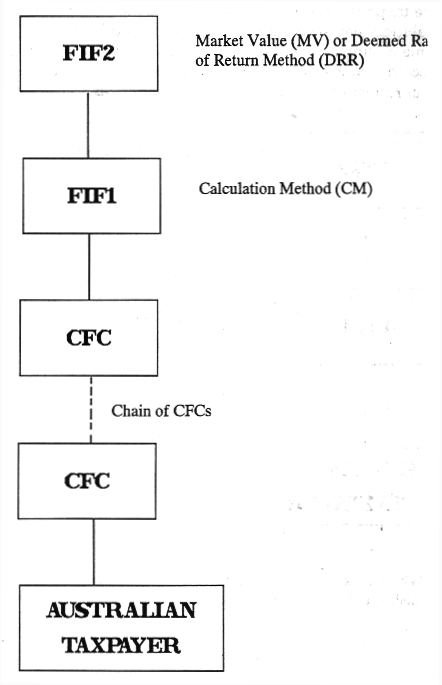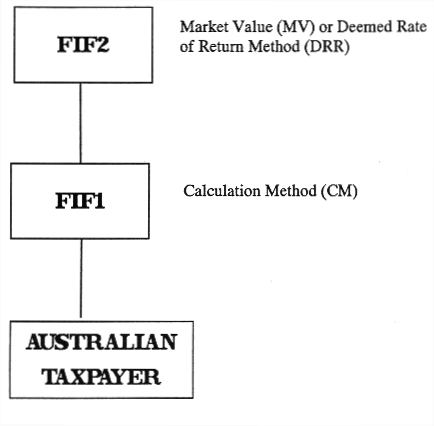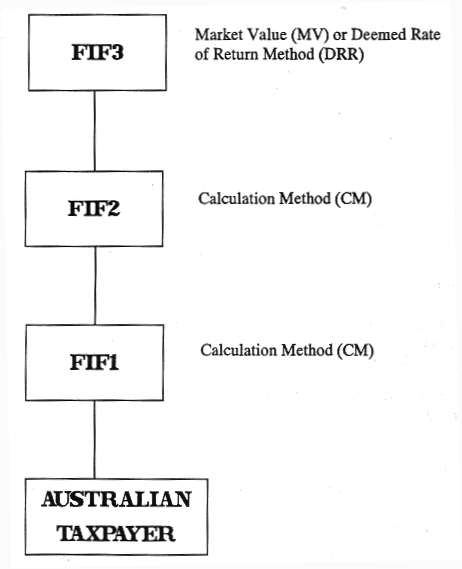Explanatory Memorandum
(Circulated by the authority of the Treasurer, the Hon John Dawkins, M.P.)Calculation Method
Overview
This chapter explains the calculation method of determining whether any Foreign Investment Fund ( FIF) income accrued to the taxpayer.
The general scheme for the calculation method
The starting points for determining the calculated profit or loss are the general provisions for the recognition of income and capital gains [section 560] and for the recognition of expenditure and other losses [section 567] . These provisions must be viewed together.
The notional income of the FIF for a particular notional accounting period includes any gross income derived by the FIF during that period. While the term 'gross income' encompasses the concept of gross receipts it is not limited to gross receipts and, in appropriate circumstances, will include a revenue profit. To determine how an amount is taken into account - that is, on a gross receipts basis or on a profit basis - regard must be had to the deduction provisions.
As a general rule, where expenditure is allowed as it is incurred, the income to which the expenses relate will be brought to account on a gross receipts basis. However, where expenditure is not brought to account as it is incurred, the income will be brought to account on a profit basis.
The general provision for deductions refers to the allowance of losses or outgoings incurred during the notional accounting period. The provision does not require that the amount be incurred in the production of notional income. There is also no exclusion of amounts that are of a capital or private nature.
It is intended that the general deduction provision would, subject to the exclusion of certain categories of outgoings etc, allow an amount as it is incurred. For example, expenditure on most trading stock would be immediately deductible. The inference is that the gross proceeds of the sale of trading stock would be brought into notional income. This can be distinguished from the case where the expenditure on trading stock is not immediately deductible, as is the case where the trading stock is land which is excluded from immediate deductibility in all cases. In this case, the inference is that the 'gross income' arising on the sale of the land would be the profit on disposal of the land, and not the gross proceeds on disposal.
The second limb of the general provision for calculating the notional income of a FIF for a notional accounting period is that profits and gains of a capital nature will also be brought to account when derived. In this case, it is expected that the amount will usually be brought to account as a net amount.
However, an amount cannot be effectively deducted twice. Thus, the net amount brought to account will exclude any amount previously taken into account. [Subsections 560(2) and 574(2)]
Why is there a departure from the general provisions of the Principal Act ?
The scheme for the determination of a calculated profit is markedly different to the general scheme of the Principal Act that arises in subsections 25(1) and 51(1). There are two reasons for this.
Firstly, on the income side, the objective is to make as little distinction as is practical between profits on revenue account and profits on capital account. This is because all profits need to be taken into account in determining the amount available for distribution.
Secondly, it is intended that the calculation be kept as simple as is possible, having regard to the scope for deferral. Thus, on the income side, there is little distinction between how revenue amounts and capital amounts are taken into account. At the same time, profits accumulating in lower tier entities and certain discounts are taken into account as they accrue to prevent unacceptable deferral of the recognition of the income.
On the deductions side, distinctions for deductibility on the basis of whether or not an item is on revenue account would preclude most taxpayer's from using the calculation method. For example, determining whether legal expenses were on capital account or revenue account would be very difficult. It is simpler to allow all expenditure immediately. This is limited only in the identified cases where the allowance of the expenditure would result in unacceptable deferral - for example, by reinvesting profits in securities - or the expenditure should be amortised and the amortisation should be readily ascertainable from the accounts.
Explanation
The calculation method will be used only if the taxpayer elects that it applies. [Section 535]
This method involves a taxpayer determining the calculated profit or calculated loss of a FIF for a notional accounting period. If there is a calculated loss, it may be carried forward and taken into account for subsequent notional accounting periods. If there is a calculated profit, the taxpayer's share of the calculated profit must be determined. This share is determined by multiplying the calculated profit of the FIF for the notional accounting period by the taxpayer's percentage interest in the FIF at the end of that period (attribution percentage). The resulting amount will be included in the taxpayer's assessable income for the year of income in which the notional accounting period of the FIF ends. [Section 558]
Determining the calculated profit or calculated loss of the FIF
In determining the calculated profit or calculated loss of a FIF, the first step is to work out the notional income of the FIF. The second step is to work out the notional deductions from that notional income. If the notional income is greater than the notional deductions then the excess is the calculated profit of the FIF for the notional accounting period. If the notional income is less than the notional deductions then the difference is the calculated loss of the FIF for the notional accounting period. [Section 559]
Application of anti-avoidance rules
Specific anti-avoidance rules to ensure that there is no avoidance in the calculation of the FIF income will not be included in these measures. Instead, reliance will be placed on the general anti-avoidance rules of Part IVA of the Principal Act.
The calculations used in determining the calculated profit or calculated loss of a FIF will be done in the currency in which the FIF keeps its accounts. Amounts derived or incurred by a FIF that are expressed in another currency may be converted to the FIF's currency on any reasonable and appropriate basis. [Subsections 559(5) and (6)]
The calculated profit of a FIF will then be converted to Australian dollars using the exchange rate prevailing on the last day of the FIF's notional accounting period. [Subsection 559(7)]
The calculated loss will be carried forward in the foreign currency.
Step 1 - Determining the notional income of a FIF
The notional income of a FIF will take into account the gross income and profits and gains of a capital or revenue nature, that are derived during the FIF's notional accounting period. [Subsection 560(1)]
The provisions of Division 16E of Part III will apply if the FIF holds a discounted security. Its purpose here is to determine whether an amount in relation to discounted securities is to be included in the notional income of the FIF of the notional accounting period. However, if an amount in relation to a discounted security is recognised in the accounts of the FIF on an accruals basis in accordance with the accounting standards of the country in which the FIF is established then the amount shown in the accounts is to be used in preference to a Division 16E application.
If the FIF was a partner in a partnership the notional income of the FIF includes its interest in any net income of the partnership calculated for the accounting period of the partnership which ends in the notional accounting period of the FIF (which ends during the year of income). The net income of the partnership is the amount by which the notional income of the partnership exceeds the notional deductions of the partnership for an accounting period of the partnership. It is calculated as though the partnership were a FIF and the accounting period of the partnership were a notional accounting period.
First tier FIF with an interest in a second tier FIF or a FLP
Where a first tier FIF has an interest in a second tier FIF, during the notional accounting period of the first tier FIF that ended during the taxpayer's year of income, generally an amount of second tier FIF income will be included in the notional income of the first tier FIF as if it was a resident. [Section 576]
In applying the FIF measures to the second tier FIF, the taxpayer will be able to elect for the calculation method to apply to that second tier FIF. To make this election the taxpayer must have elected to use the calculation method in respect of the first tier FIF which has an interest in the second tier FIF. [Subsection 577(1)]
A taxpayer will not be able to make the election to use the calculation method in respect of the third tier FIF where the first tier FIF is a CFC. Instead, the taxpayer will use either the market value or the deemed rate of return method for the third tier FIF. The following diagram illustrates this. [Section 577(2)]


If the taxpayer does not make an election to use the calculation method in respect of the second tier FIF, the FIF income arising from the second tier FIF is to be calculated in accordance with the market value method or the deemed rate of return method, as illustrated. [Section 535]

Where the taxpayer has made an election to use the calculation method in respect of the second tier FIF the notional income of the second tier FIF will include FIF income from a third tier FIF or a FLP, as illustrated. [Section 579]

The notional income of the FIF in respect of the notional accounting period which ended during the year of income does not include any dividend or distribution paid to the FIF by another FIF. [Section 564]
The existing rules for constructive receipt of income, profits or gains will be incorporated in the calculation. Any amount that is reinvested, accumulated, capitalised, carried to a reserve, sinking fund or insurance fund will be taken to have been derived by the FIF. Income, profits or gains will be taken into account in calculating the notional income of the FIF even where the income, profit or gains are not actually paid to the FIF but are dealt with on behalf of the FIF or on its direction. [Section 565]
An amount included in the notional income of the FIF is to be included as a pre-tax amount. [Section 566]
Step 2 - Determining the notional deductions
Most expenses of the taxpayer will be deductible in the notional accounting period in which they are incurred, provided that the expenses relate to income and profits or gains of a revenue nature included in the determination of the notional income of the FIF. [Section 567]
Expenditure on trading stock will be a notional deduction in the period in which it is incurred. [Section 568]
A notional deduction will not be allowed for expenditure of a capital nature in the acquisition of shares or interests in shares in a company, interests in a trust, or other securities. Instead, the cost will be taken into account in determining any profit or loss on disposal of the interest. [Section 569]
Expenditure on the purchase of certain assets will be amortised over the effective life of the asset. This will apply to assets such as plant and equipment, licences, patents and any other assets prescribed by regulation. The amount shown in the accounts of a FIF will be deducted if:
- he accounts conform with generally accepted accounting principles;
- he accounts give a true and fair view of the financial position of the FIF; and
- he accounting principles provide for the amount to be amortised over the effective life of the asset - that is, the value of the asset is not written off immediately the expenditure is incurred. [Subsection 570(1)]
Expenditure on the acquisition of any other property will not be amortised. [Subsection 570(2)]
The interest of a FIF in a partnership loss will be allowed as a notional deduction where the FIF was a partner in a partnership at the end of the accounting period of the partnership which ends in the notional accounting period of the FIF. A partnership loss is the amount by which the notional deductions of the partnership exceed the notional income of the partnership for an accounting period of the partnership. The amount is calculated as though the partnership were a FIF and the accounting period of the partnership were a notional accounting period. [Section 571]
Calculated losses of a first tier FIF arising in previous notional accounting periods, that have not been allowed as a notional deduction can be recouped in the current notional accounting period against the calculated profit of the first tier FIF [subsection 572(1)]. These loss deductions are used in the order in which they occurred. [Subsection 572(2)]
Similarly, calculated losses of a second tier FIF arising in previous notional accounting periods, that have not been allowed as a notional deduction can be recouped, in the current notional accounting period of the second tier FIF, against the calculated profit of a second tier FIF. These loss deduction are allowed in the order in which they occurred. [Section 578]
A notional deduction will be allowed from the notional income of the FIF for Australian tax and foreign taxes paid by the FIF to the extent that the tax relates to the income or gains included in the calculation of the notional income of the FIF. [Section 573]
A notional deduction is not allowed from the income of the FIF for expenditure incurred by the FIF during the notional accounting period in respect of the acquisition of:
- lant, articles or industrial or other property referred to in paragraph 570(1)(a);
- and or buildings;
- oodwill;
- old, silver or other precious metals; or
- ny other capital assets. [Subsection 574(1)]
However, expenditure which is associated with these, for example, legal fees, is not precluded by this subsection. There is a further exclusion for all expenditure incurred in the repayment of debts.
An amount is not allowed as a notional deduction from the notional income of the FIF in respect of the notional accounting period of the FIF to the extent to which:
- he deduction has been taken into account in calculating a net amount that has been, or will be, included in the notional income of the FIF for the notional accounting period or of a previous notional accounting period; or
- he deduction would have been taken into account in calculating a net amount that would have been, or would be, included in the notional income of the FIF for a previous notional accounting period had the taxpayer been required to calculate the notional income for that previous notional accounting period.
The purpose of this subsection is to prevent the same expenditure being allowed more than once as a notional deduction. [Subsection 574(2)]
Step 3 - Calculate the taxpayer's attribution percentage in respect of interests in the FIF
A taxpayer's attribution percentage in respect of interests in a foreign company
The taxpayer has to include in assessable income the taxpayer's attribution percentage of a FIF's calculated profit. The attribution percentage will reflect the greatest of the taxpayer's rights in relation to the FIF to receive income or capital or to participate in decision making. [Subsection 581(1)]
At the end of the relevant period, a taxpayer's FIF attribution percentage in relation to a company will be equal to the percentage that the taxpayer holds or is 'entitled to acquire' (see Chapter 2 - Key Concepts) in:
- he total paid-up share capital of the company;
- he total rights to vote, or to participate in decision making, in relation to distributions of profit or capital of the company;
- he total rights to vote, or to participate in decision making, in relation to the constituent document of the company;
- he total rights to vote, or to participate in decision making, in relation to a variation to the share capital of the company; or
- he total rights to distributions of profits or capital on winding-up, or at any other time.
Where different percentages arise under the different types of rights described above then the FIF attribution percentage will be the greatest of those percentages. [Subsections 581(1) and (2)]
The attribution percentage is worked out on the basis of the:
- apital of the company at the end of the notional accounting period; or
- he profits of the company for the notional accounting period. [Paragraph 581(3)(a)]
It is assumed that the taxpayer's 'rights' in relation to the FIF at the end of the relevant period applied at all times throughout the applicable period. [Paragraph 581(3)(b)]
Attribution percentage applicable to a taxpayer's interests in a foreign trust
If the beneficiaries of the trust are presently entitled to, or if the trustee distributes or allocates to the beneficiaries, all of the income, profits or gains of a foreign trust that arise during the trust's notional accounting period, then the taxpayer's attribution percentage will be calculated by reference to the present entitlement and the amount distributed to the taxpayer out of the income, profits or gains. [Subsection 582(2)]
The distributions have to be made within the notional accounting period or within two months of the end of the notional accounting period.
The income, profits or gains referred to are not the net income for Division 6 purposes. Instead they are the accounting income, profits or gains of the trust.
If the income, profits or gains of the foreign trust are not fully distributed or allocated to beneficiaries, as described above, then the taxpayer's attribution percentage will be equal to the greater of the percentages of the taxpayer's interest in, and entitlement to acquire:
- he income of the trust; or
- he corpus of the trust. [Subsection 582(7)]
The attribution percentage is worked out on the basis of the:
- ncome of the trust for the period; or
- he corpus of the trust at the end of the period. [Subsection 582(6)]
It is assumed that the taxpayer's rights in relation to the foreign trust at the end of the relevant period applied at all times throughout the year of income. [Paragraph 582(7)]
Step 4 - Determining the amount to be included in the taxpayer's assessable income
Taxpayer's FIF interest does not change
In general, the amount to be included in the taxpayer's assessable income will be determined by multiplying the calculated profit of the FIF for the notional accounting period by the taxpayer's percentage interest in the FIF at the end of that period (attribution percentage). [Sections 580 and 582]
Taxpayer's share of FIF income = Calculated profit x Attribution percentage
Example 1
Assume a taxpayer has a one per cent interest in a FIF for the entire notional accounting period for which the calculated profit of the FIF is $A10 million. Assume also the FIF fails the active business exemption and that the taxpayer elects to use the calculation method. The taxpayer would include $A100,000 in assessable income as follows:
$A10 million x 1% = $A100,000
If the taxpayer acquired an interest in a FIF during a notional accounting period, the above formula is modified by multiplying it by the proportion of the number of days throughout the period in which the taxpayer held the interest [subsections 580(3) and 582(5)]. The calculation method will only apply to an interest or interests in a FIF held at the end of the relevant period. [Subsections 580(5) and 582(9)]
Taxpayers share of income = Calculated profit x Attribution percentage x (Number of days held / Total number of days)
Example 2
As in the previous example, assume a taxpayer has a one per cent interest in a FIF. However, the interest was acquired 60 days into the FIF's notional accounting period and was still held at the end of that period. The calculated profit of the FIF is $A10 million. Assume also that the FIF fails the active business exemption and that the taxpayer elects to use the calculation method. The taxpayer would include $A83,561 in assessable income as follows:
$A10 million x 1% x (365-60/365) = $A83,561
Where a taxpayer holds an interest in a FIF during a notional accounting period and adds to, or reduces, that interest during the period, the amount included in assessable income will be altered to reflect the changing size of the attribution percentage.
Example 3
Assume that a taxpayer has a one per cent interest in a FIF at the beginning of the FIF's notional accounting period, and buys another two per cent 100 days into the period. There are no disposals by the end of therelevant period. Assume also that the FIF fails the active business exemption, the taxpayer elects for the calculation method and the calculated profit of the FIF is $A10 million. The taxpayer would include A$245,205 in assessable income as follows:
$A10 million x 1% + (2% x 265/365)] = $A245,205
Example 4
Assume the same facts as in the previous example except that the taxpayer sells half of the one per cent interest 100 days into the FIF's notional accounting period, and acquires the two per cent interest 50 days before the end of the period. The amount included in assessable income would be A$77,397, calculated as follows:
$A10 million x [0.5% + (2% x 50/365)]
= $A10 million x 0.77397%
= $A77,397
Example 5
The facts differ from those in the previous example in that the taxpayer sells all of the one per cent interest 100 days into the FIF's notional accounting period. As the one per cent interest was disposed of before the end of therelevant periodit is not taken into consideration under the FIF measures. The assessable income of the taxpayer under the FIF measures would include $27,397 in respect of the two per cent interest acquired 50 days before the end of the period, calculated as follows:
$A10 million x [2% x 50/365] = $A27,397
